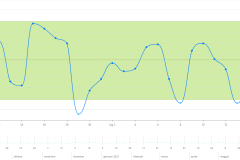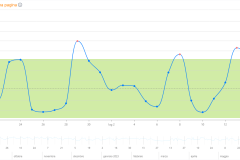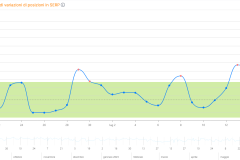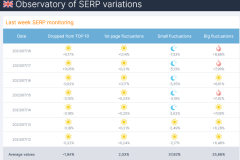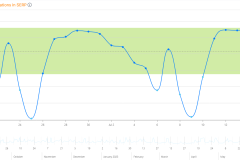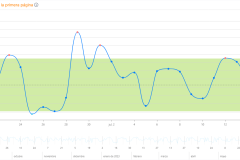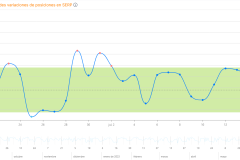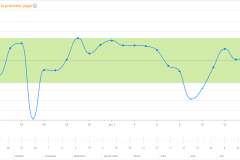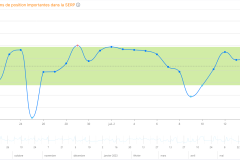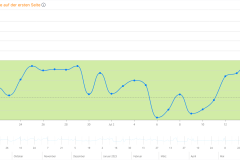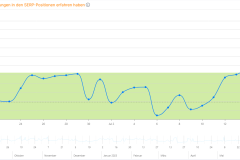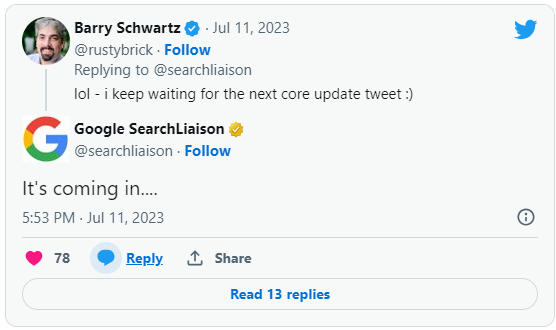Google SERPs, what is behind this extreme volatility?
Like the Hogwarts stairs in the world of Harry Potter, Google’s SERPs like to change, we know that by now. Yet what has internationally been happening in the last few days has few precedents, at least from the point of view of intensity: our SERP Observatory, and also our other tools for monitoring changes in rankings, are indeed reporting extreme volatility in placements, with high peaks compared to regular average activity. But it is precisely our tool that also makes us realize an additional relevant fact: these movements are not fully perceived at the traffic level because they mainly affect Google pages following the first one.
Traffic variations on Google, what is going on
International experts have already called it a Googlequake: for the past few days, analytical tools have been finding extreme levels of volatility in Google search results internationally, with data way out of scale with respect to regular average values.
The situation is so abnormal that Barry Schwartz, as usual very keen on catching everything going on in the Google world and community in a timely manner, has even speculated that this “crazy Google volatility” has somehow broken the automated SERP tracking tools, which since last weekend have been presenting numbers and values never shown before.
The other bizarre aspect, in fact, is that the SEO community has no particular pulse on these variations, because there are apparently no similarly intense reports of fluctuations in traffic, visits and conversions.
In other words, what is surprising is not only the amount of fluctuations being recorded, but also (if not especially) the fact that site owners are not complaining about particular losses-or at any rate not noticing such intense flips as the Googlequake might suggest.
Analysis with SEOZoom to understand the fluctuations
With SEOZoom we investigated these fluctuations for the SERPs of UK, ES, FR, DE and Italy, and thanks to the greater granularity of the data available within our software we have a possible logical explanation for this phenomenon.
The SERP Observatory, in fact, goes deep into the analysis of variations in Google’s SERPs and, in particular, manages to separate them by type, dividing the fluctuations into Exits from Top10, First Page Fluctuations, Large Variations and Small Variations.
As can be seen from the screens below, almost in all the investigated databases the result is similar: these intense movements mainly concern two specific segments, i.e., the exchange of positions within the top10 and ranking fluctuations in pages from the second to the fifth Google page.
This may therefore explain what is going on: internationally, there are no relevant fluctuations for Google’s top 10, because there are really no new or exited URLs, but only reshuffles in the ranking of URLs already positioned within the first page. Because of this, sites have not had any major changes in terms of traffic detected, because they have “only” gained or lost a few positions while still remaining within the top 10 results of Google’s coveted first page. Instead, the big earthquake is affecting the subsequent pages of the search engine, where indeed we are reporting only huge changes in position that, however, have less impact on actual traffic and especially on traffic estimated by SEO tools.
In short, what is happening seems to be a reconsideration of pages that do not rank well but have the potential to aspire to the first page, which somehow Google is pushing up to page 2 and, who knows, to even higher positions in the future.
What is Google preparing?
Obviously, understanding the data and taking pictures of the current situation is only part of the problem, because what we would really be interested in knowing is “why” we are experiencing this Googlequake phase.
At the moment we can only speculate, because there is a lack of official news from Google – which, in any case, performs so many changes and tests on the algorithm on a daily basis, not all of them confirmed: some analysts have speculated that we are at the primordial stages of a broad core update, also because the last one was the March 2023 Core Update (and because, we add, Google often enjoys launching these heavy interventions right around August and the vacations!), while others even think of an update that is already in progress but not confirmed.
As mentioned, there is no confirmation or denial, although a few days ago Search Liaison Danny Sullivan joked with Barry Schwartz, first hinting that a broad core update was imminent and then explaining his thinking further with a reference to the TV series Arrested Development and the “banana stand.” To clarify, in short, there is always room for a Google update, Sullivan said, because algorithm improvement activity is always going on, but minor changes are not always communicated with standalone announcements, which are reserved instead for larger, more impactful updates that are also officially presented to the community.
Ultimately, we’ll just have to wait, keep an eye on the Google Search Status Dashboard (and our blog) for updates… and cross our fingers!



